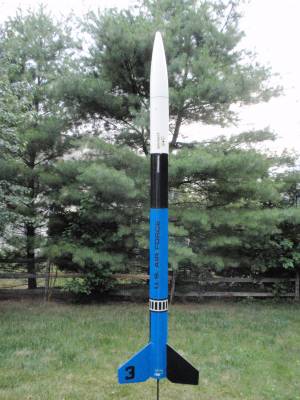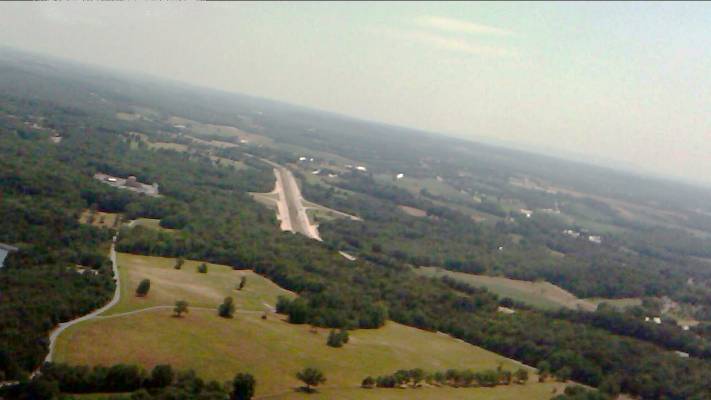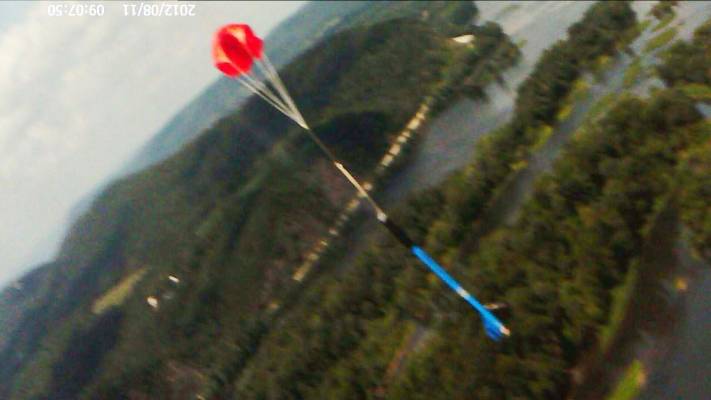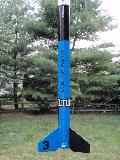| Manufacturer: | Estes  |
The Bandit: Apparently this is NOT the modern Estes "Bandit". (I hate when Estes re-uses model names!!!) This is a beautiful favorite, classic kit from the '70s. This model had built-in ejection gas baffles that require no wadding (in theory). The model also included a reasonably large payload section of 4-1/2 cubic inches. I recently added vent holes for a barometric altimeter. My kit was built with a wire down the main tube to be used as a transmitter antenna (but not used anymore, it was for a high-school science project - won 2nd place!). I used an alternate, longer payload tube and nosecone with features just for the transmitter.
Usually I fly it with a little 'safety' wadding, when I didn't, the 12" chute seriously stuck together but not totally melted, probably because of its age(?). For its weight, it should have a 15-inch parachute anyway. It has been rebuilt with a more reliable nylon parachute. After some motor mount damage on its last flight due to a faulty parachute deployment, this model has been re-built with a better, smaller ejection baffle and a bigger 95mm long motor mount that can handle 24mm wide C, D and E motors, and using an adaptor, the standard 18mm B, C and (composite) D motors. This model of the Bandit I now call the Bantid II.
It now flies very well and quite high with the new motor options! Before it was limited to 400+ feet on a C6 motor; flying higher than the Saturn V Apollo spacecraft, and the Spire of Dublin. With the new mount and a D12 motor, this rocket can fly higher than the Eiffel Tower, the Two Prudential Plaza in Chicago, the Chrysler Building in NY, and the JP Morgan Chase Tower in Houston. If the fins don't shear off, could it even break 2K with a strong E-motor? We'll find out...
---
I have selected this rocket to be the booster for my tiny HD video camera payload. I figure with it's weight, it will only reach about 1/2 its usual altitude: about 500 feet on the D12-5, which should be good enough for aerial photographs. If I need more, I can use the E9. That should certianly lift the 50-gram payload to 1000 feet. I could also try the newer Estes E12! The other modification for the HD camera is that the shock cord is removed, and the rocket will use its own 12" parachute, while the payload section has three 9" parachutes (for redundancy). This way I don't have to worry about the shock-cord snap-back or it separating. I also have a bit of redundancy in the camera's parachutes, if one (or even two) fail to open, hopefully the payload will still fall slow enough to survive.
The seperate parachutes will also allow the camera to fall while still oriented vertical (upside-down), and maybe with less swaying. This version of the Bandit is re-renamed the Bandit HD. The payload bay is now about 7-1/2" long and houses both the Altimeter Two and the camera. A special window was installed in the side of the tube that will screen out UV light to keep the camera sensor working well. It is glass taken from good pair of mirrored sunglasses. My first window attempt used a plastic window, which was the last item to install after all the finishing was done. The night before launch, I glued the window in with CA glue, and it hazed over from the chemicals in the CA, so the flights were scubbed and I cut out the old window and installed the better one. That's why it looks so ugly around the window area (see photo). Next time (I'm making a new booster just for this camera) I'll glue in the non-plastic window then use filler putty to smooth out the edges before painting it. Unlike any other rocket camera project I've ever seen the results of, this camera is oriented horizontal and should take a horizon picture from launch to near apogee. It will NOT look down like all the others. I hope to launch this simultaneously with other rockets to get photos and video of other rockets flying FROM THE AIR! Ideally, I'll get an apogee and 'chute deployment from the air. That would be very different and so cool! So check back!
---
While the Bandit performed well and risked its life a few times in the execution of its photography missions, it has been retired as a camera platform while newer rockets take over the task. The Bandit has been returned to its sport/payload configuration with a 24mm D mount after the E mount was severely damaged. The baffle has been drilled-out and instead a 6x6" Nomex sheet is being used since I have found them to be more reliable. Long live the Bandit!
Flights
Sponsored Ads
 |
 |











































